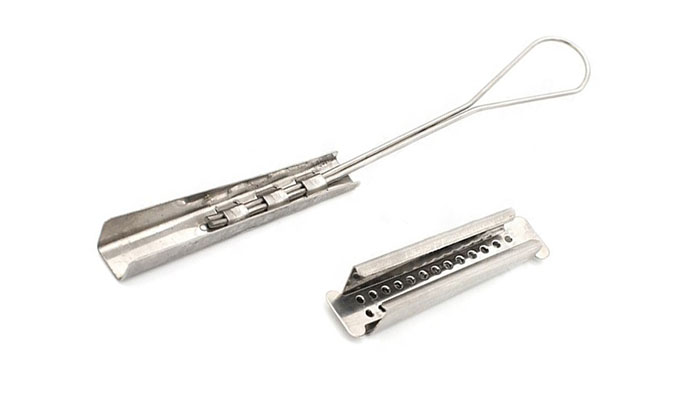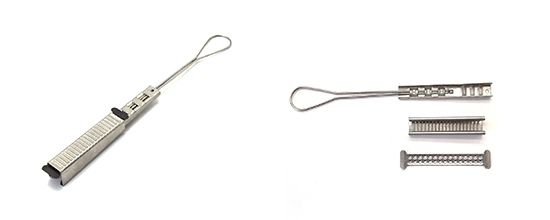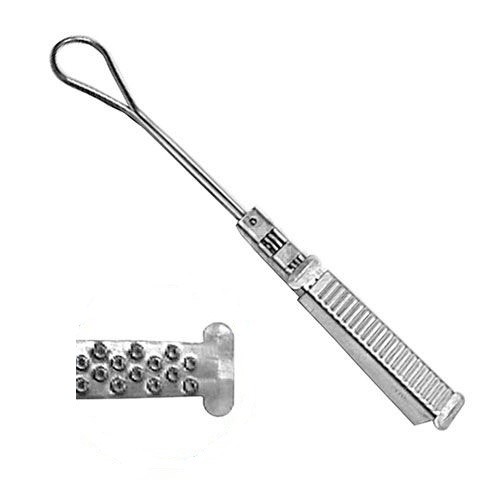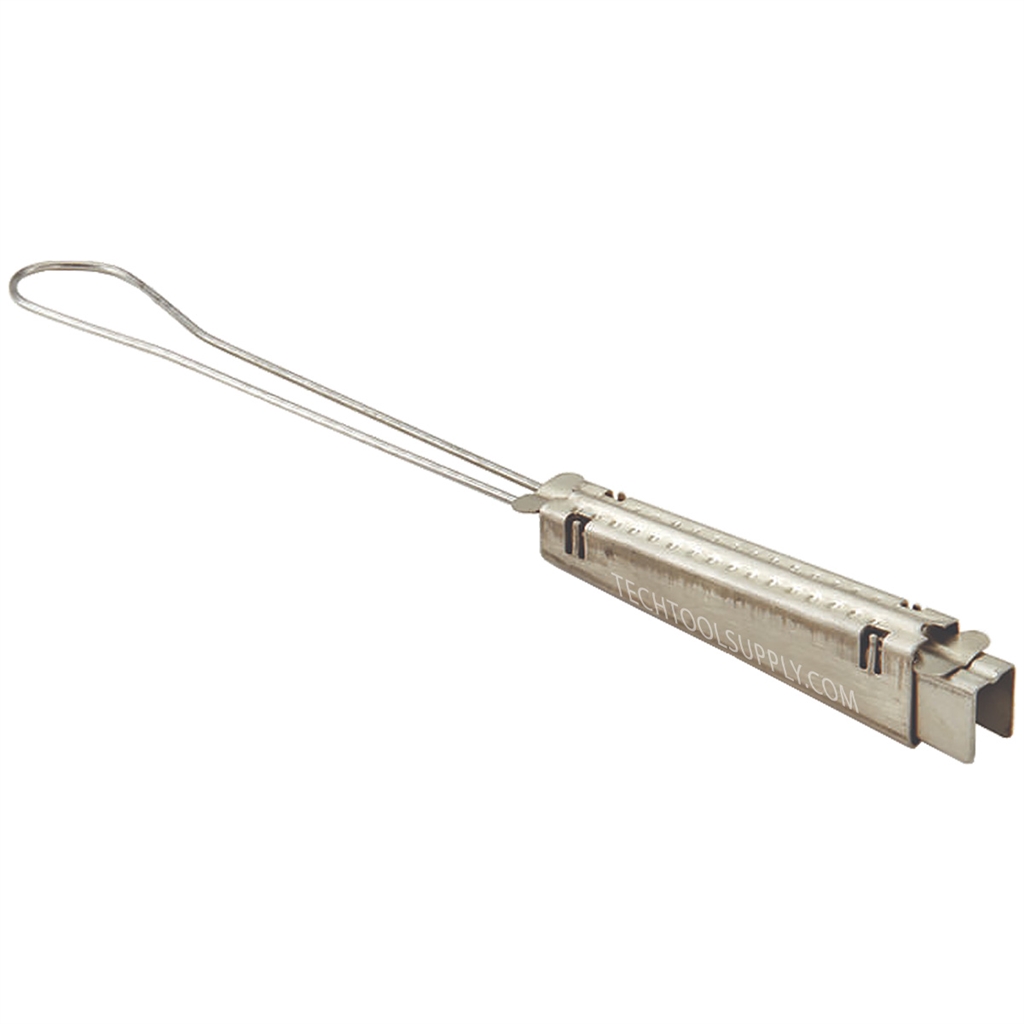
A drop wire clamp is a piece of hardware used in cable television and telecommunications to support and secure aerial lines. The clamps work with aerial cables that hang from support structures and installed above ground. Their primary job is to secure the cables that hold up the structure. This lessens the chance of damage, swinging or sagging. These circumstances are from factors like wind, storms, the weather and mechanical stress. Strong construction materials work in the design of drop wire clamps for aerial cables. These consist of aluminum or galvanized steel. Insulating materials may be useful in the clamps to keep the clamp and cable from coming into contact. These clamps ensure communications integrity, stability and dependability. Applications like internet service providers and surveillance systems use clamps.
Types of aerial cable drop wire clamps
Drop wire clamps come in several varieties intended to work with aerial cables. The features of the clamps change to hold various cable arrangements, sizes and installation needs. The type of cable, the installation requirements and the surrounding conditions, all play a role in choosing the appropriate clamps. The most popular kinds of drop wire clamps for aerial wires are as listed below.

- Universal drop wire clamps – these clamps are capable of supporting a large variety of cable sizes and kinds. These components can adjust to give installations flexibility.
- Fiber optic clamps – cables made to support fiber optic cables are present in fiber optic drop wire clamps. This is particularly true for high-speed internet networks and telephony. They have features that prevent harm to delicate fiber optic wires.
- Adjustable drop wire clamp – these clamps can accommodate different kinds of cables. They are flexible and can adjust to different wire diameters.
- Changer drop wire clamps – clamps called hanger drop wire clamps fasten aerial cables to hangers. They give the cables a safe place to attach.
- Snap-on drop wire clamps – these have designs to quickly and easily install. They feature a locking mechanism. The clamps can adjust to fit a variety of applications.
- Coaxial drop wire clamp – clamps designed for use in cable television systems and broadband internet installations are coaxial cable drop wire clamps. They offer a safe and secure hold on the coaxial cable.
- Insulated drop wire clamp – insulating materials work in insulated drop wire clamps to keep electricity from passing through the clamp and onto the aerial cable. This improves security and avoids signal interference.
- Corrosion resistant drop wire clamps – these are clamps made of corrosion-resistant materials. They are thus appropriate for exterior installations.
Aerial cable drop wire clamps
Aerial cable drop wire clamps are parts used to support and secure wires installed above ground. The clamps support the upkeep of aerial cable installations’ functioning and integrity. This is to guarantee correct cable alignment, tension and environmental factor protection. They serve to fasten the aerial cables to the supporting frameworks. Their designs ease easy installation and modification while offering a firm hold on the cable. Designs that are commonly used include bolted, Snap-on or suspension versions. Drop wire clamps install throughout the aerial cable’s length to secure the cable to the supporting structure. Depending on the application and design of the clamp, fasteners, bolts or other mounting hardware may be necessary for installation.
Drop wire clamps characteristics
Drop wire clamps are appropriate for a variety of applications due to their many essential characteristics. For different kinds of cable, the attributes offer dependable stability, protection and support. It’s also a good idea to consult an expert when evaluating the properties of drop wire clamps.

- Durability – materials like stainless steel, aluminum or galvanized steel work in making the clamps. They are resistant to rust, corrosion and wear from machinery. Long-term performance and protection from the weather are from it.
- Insulation – materials work in certain clamps to create an electrical barrier between the clamp and the aerial cable. To improve safety and dependability, this avoids electrical contact and lowers the possibility of short circuits.
- Installation simplicity – with features like Snap-On mechanisms, the clamps provide quick and simple installation. They speed up and streamline the installation procedure for aerial cable installations.
- Load bearing capacity – the clamps have designs to sustain the weight and stress of aerial cables without breaking. To lessen the strain on the wires and guarantee dependable operation, the load is equally distributed throughout the support structure.
- Strength – they guarantee the stability of aerial cables by offering robust and dependable support. in various environmental circumstances.
- Adjustability – to suit a range of cable diameters and configurations, the clamps have adjustable components. This makes installation simple and guarantees a tight fit for many kinds of aerial cables.
- Compatibility – a variety of aerial cable types are compatible with the clamps. This covers electrical lines, fiber optic cables and coaxial cables. To accommodate various cable types and installation needs, they come in a variety of sizes and configurations.
- Costs – drop wire clamps are an affordable way to secure aerial cables. This offers strong support and defense at affordable costs. They also contribute to lower maintenance and replacement expenses over the installation’s lifetime.
Components used to make the drop wire clamps
The materials used to make drop wire clamps are resistant to outside conditions. They offer dependable help for aerial cables. The choice of material depends on various aspects, including cost, durability, application and environmental circumstances. Seeking advice on the best materials from industry professionals is also a good idea. The following are typical components used in drop wire clamp production.

- Insulated materials – materials that act as insulation include rubber and plastic. Electrical insulation is from these materials between the aerial cable and the clamp. Additionally, it lessens the chance of short circuits and prevents electrical contact.
- Bronze – this is a useful material for several applications where wear and corrosion resistance are necessary. Excellent electrical conductivity characterizes the substance.
- Stainless steel – this is a corrosion-resistant material that works well for drop wire clamps in challenging conditions. For efficiency, the material provides lifespan and durability.
- Galvanized steel – this is a strong, affordable, resistant to corrosion and durable material. It is effective for aerial cables that need robust safeguarding and support.
- Aluminum – this is a lightweight, strong material that works well for drop wire clamps that support aerial cables.
- Composite materials – fiberglass-reinforced polymers and other composite materials work in some of the clamps. The materials provide a blend of resilience, robustness and insulating qualities.
- Coated metals – these comprise metals covered in coatings that offer protection. They improve its durability and resistance to corrosion. Powder coatings, epoxy coatings and zinc plating are examples of common coatings.
Drop wire clamps applications in aerial wires
In aerial cable installations, the clamps have a variety of functions. This entails offering stability, support and avoiding sagging. Their operation guarantees safe and effective installation of aerial cables in a variety of settings. Choosing a clamp that meets the requirements of your application is also crucial. In aerial cable installations, drop wire clamps work for the purposes listed below.

- Supporting Many Cable Types – the clamps work with a range of aerial cable types. This covers electrical lines, fiber optic cables and coaxial cables. They offer support for various applications and cable layouts.
- Cable management – the wire clamps give aerial cables a neat and safe place to attach. To avoid cable entanglement, this improves effective cable management and maintenance.
- Cable tension management – to keep the aerial cables tensioned, they also distribute tension along their whole length. In the case of telecommunications, this stops cable sagging and preserves signal integrity.
- Anchoring aerial wires to support structures – drop wire clamps secure aerial cables to support structures. This keeps the cables from sagging and guarantees that they are align.
- Preventing cable damage – by keeping the aerial cables in their proper positions, you may shield them from weather, wind and mechanical strain. They lessen the chance of wear or abrasion as well as cable movement.
- Safety – by using the clamps, the chance of accidents resulting from cable sagging into infrastructure and roads decreases. By securing the cables and averting dangers, the clamps improve safety.
- Increased dependability – the upkeep of aerial cables relies in the clamps. They guarantee simple access for inspection and aid in preventing cable tangling.
- Adherence to regulations – the majority of regulatory codes dictate that aerial cable installations use drop wire clamps. This is to guarantee that the performance and safety standards are safe.
Frequently asked questions
A drop wire clamps for aerial cables is a component used to secure and support cables installed on support structures. Its main function is to prevent cable sagging, ensure proper alignment and protect against environmental damage.
Drop wire clamps are from durable materials such as galvanized steel, aluminum or stainless steel. These materials help withstand outdoor conditions and resist corrosion.
Drop wire clamps are compatible with various types of aerial cables. This is including coaxial cables, fiber optic cables, electrical wires and communication cables.
